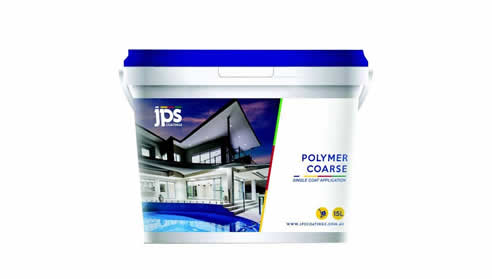Acrylic-Based Polymer Render with Polyrend Coarse

Acrylic rendering has become a staple rendering method because of its ability to create a high tensile architectural and durable exterior wall finish. It is applied by hawk and trowel. The acrylic resin compound found in Polyrend Coarse acrylic-based polymer render provides excellent adhesion and flexibility compared to other rendering materials.
It is a well known fact that built structures contract and expand over time. This natural movement causes unsightly hairline cracks to appear across the wall surface. The breakage on the wall surface can
lead to other levels of structural deterioration. The wall paint may start to stain, peel or bulge with water infiltration, and create the perfect breeding ground for mould and mildew.
Applying fresh coats of paint to hide the cracks and keep the wall looking good as new, can be costly and time-consuming. All of this can be avoided by using acrylic-based polymer render.
Polyrend Coarse is a high-build, acrylic-based patching compound from JPS Coatings. It comes as a semi-liquid, dispensable paste. Acrylic rendering with Polyrend Coarse exhibits minimal shrinkage while curing, and exceptional adhesion to masonry surfaces.
Polyrend Coarse is often used as base filler for larger surface irregularities. It can be applied on surface irregularities & blemishes of up to 6 mm per coat in a single coat. Skim coating over flush jointed block work prior to texture coating application is also made possible with Polyrend Coarse.

Practical spreading rates depend on the method of application and the condition during its usage. A bucket of Polyrend Coarse has a typical spreading rate of 0.5 m² per litre. Assuming there is no loss, its spreading rate will correspond to 2,000 microns dry film thickness at approximately 7 to 8 m².
Polyrend Coarse acrylic-based polymer render requires mixing with the addition of 15% clean Portland cement and water to achieve the desired consistency of the patching compound. The substrate wall must be dry and free from dirt, oil and other substances that can hinder adhesion.
Polyrend Coarse Application
Using a stainless steel trowel and hawk, apply Polyrend Coarse on the wall surface and avoid overworking the surface area. To achieve a semi-smooth finish, even out the surface by using a plastic diamond float, polystyrene, or a sponge, while the coating is still moist.
Observing proper temperature and weather condition is always good practice in the application of Polyrend Coarse. The ideal working temperature must be above 7°C and below 32°C. Always choose to work under a shaded area to protect the mixture and facilitate proper curing time. Also, avoid application of the acrylic-based polymer render during extreme heat and windy conditions.
Another benefit of using acrylic-based polymer render is its ability to reduce the curing or drying time. Unlike traditional rendering materials like sand and cement, applicators don't need to wait for a couple of days, or even a week, before they can recoat the rendered wall surface.
Polyrend Coarse is Touch Dry in 60 minutes after application at 25°C and 50% relative humidity. However, curing might take longer for lower temperatures and higher relative humidity. With the right temperature, Polyrend Coarse can be recoated with the choice texture coating the very next day.
Polyrend Coarse can be overcoated with JPS Coatings innovative Tex-Guard decorative sealer texture coating for maximum acrylic rendering protection.
JPS Coatings is a convenient one-stop shop for all your rendering needs. Contact JPS Coatings for more details on Polyrend Coarse and other acrylic-based polymer render materials today.

|





 Polyboard Acrylic Modified Render from
Polyboard Acrylic Modified Render from Easy DIY Architectural Finishes from JPS
Easy DIY Architectural Finishes from JPS PolyBoard Acrylic Modified Render from
PolyBoard Acrylic Modified Render from How to Apply Exterior Texture Coatings
How to Apply Exterior Texture Coatings Evolving Elements Water Based Acrylic
Evolving Elements Water Based Acrylic Achieve Sustainability with Cova-Wall
Achieve Sustainability with Cova-Wall Self-Priming Acrylic Exterior Paints
Self-Priming Acrylic Exterior Paints Elastomeric Roof Coating: Evolving
Elastomeric Roof Coating: Evolving Evolving Elements Terraglaze Plus+
Evolving Elements Terraglaze Plus+ Surface Preparation with Evolving
Surface Preparation with Evolving Freedom to Design with Cova-Wall
Freedom to Design with Cova-Wall Rendering with Acrylic Polymer Render &
Rendering with Acrylic Polymer Render & Applying Evolving Elements Acrylic
Applying Evolving Elements Acrylic The Benefits of Waterproof Roof Coating
The Benefits of Waterproof Roof Coating Evolving Elements Quality Acrylic
Evolving Elements Quality Acrylic Premium Interior House Paints for a
Premium Interior House Paints for a Tex Guard Pigmented Acrylic Coating:
Tex Guard Pigmented Acrylic Coating: Highly Integrated Professional Roof
Highly Integrated Professional Roof Cova-Wall Certified Polystyrene Cladding
Cova-Wall Certified Polystyrene Cladding Dry Mix and Polymer External Wall
Dry Mix and Polymer External Wall
